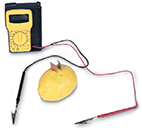Quick Lab
Making a Battery
Materials
1 large fresh lemon, plastic knife, zinc strip, 2 copper strips, multimeter

Procedure 
Roll the lemon between your hands until it softens.
Use the knife to carefully cut two parallel slits in the lemon about 1 cm apart. Push the copper strips into the slits to a depth of 2 to 3 cm. Don't allow the strips to touch.
Attach the copper strips to the terminals of the multimeter. Observe the reading and record it.
Replace one of the copper strips with the zinc strip and repeat step 3.
Analyze and Conclude
Observing What was the reading on the multimeter when you used two copper strips? A copper and a zinc strip?
Predicting Lemon juice is acidic. Would a basic solution provide a similar result?
Strong Acids
When hydrogen chloride dissolves in water, almost all of its molecules ionize. After the reaction, there are about the same number of hydronium ions in solution as there were molecules of HCl to begin with. The products do not reform reactant molecules. HCl is an example of a strong acid.  When strong acids dissolve in water, they ionize almost completely. Other strong acids include sulfuric acid, H2SO4, and nitric acid, HNO3.
When strong acids dissolve in water, they ionize almost completely. Other strong acids include sulfuric acid, H2SO4, and nitric acid, HNO3.
Strong Bases
When dissolved in water, sodium hydroxide almost completely dissociates into sodium and hydroxide ions. Sodium hydroxide is an example of a strong base.  Strong bases dissociate almost completely in water. Other strong bases include calcium hydroxide, Ca(OH)2, and potassium hydroxide, KOH.
Strong bases dissociate almost completely in water. Other strong bases include calcium hydroxide, Ca(OH)2, and potassium hydroxide, KOH.
Weak Acids and Bases
The citric acid in orange juice and the acetic acid in vinegar are weak acids. Toothpaste and shampoo contain weak bases.  Weak acids and bases ionize or dissociate only slightly in water.
Weak acids and bases ionize or dissociate only slightly in water.
Weak Acids
A solution of acetic acid, CH3COOH, and water can be described by the following equation.
The equilibrium favors the reactants over the products, so few ions form in solution. A weak acid forms fewer hydronium ions than a strong acid of the same concentration. This also means that a weak acid has a higher pH than a strong acid of the same concentration.
It is important to understand the difference between concentration and strength. Concentration is the amount of solute dissolved in a given amount of solution. Strength refers to the solute's tendency to form ions in water. You cannot assume that a strong acid has a low pH, because its concentration also affects pH. For instance, a dilute solution of HCl (a strong acid) can have a pH of 6. But a concentrated solution of acetic acid (a weak acid) can have a pH of 3.
Weak Bases
Ammonia, NH3, is a colorless gas with a distinctive smell. When it dissolves in water, very little of it ionizes. Equilibrium favors the reactants, so few NH4+ and OH− ions are produced.
Buffers
Weak acids and bases can be used to make buffers. A buffer is a solution that is resistant to large changes in pH. Buffers can be prepared by mixing a weak acid and its salt or a weak base and its salt. Because a buffer can react with both an acid and a base, its pH remains relatively constant.




